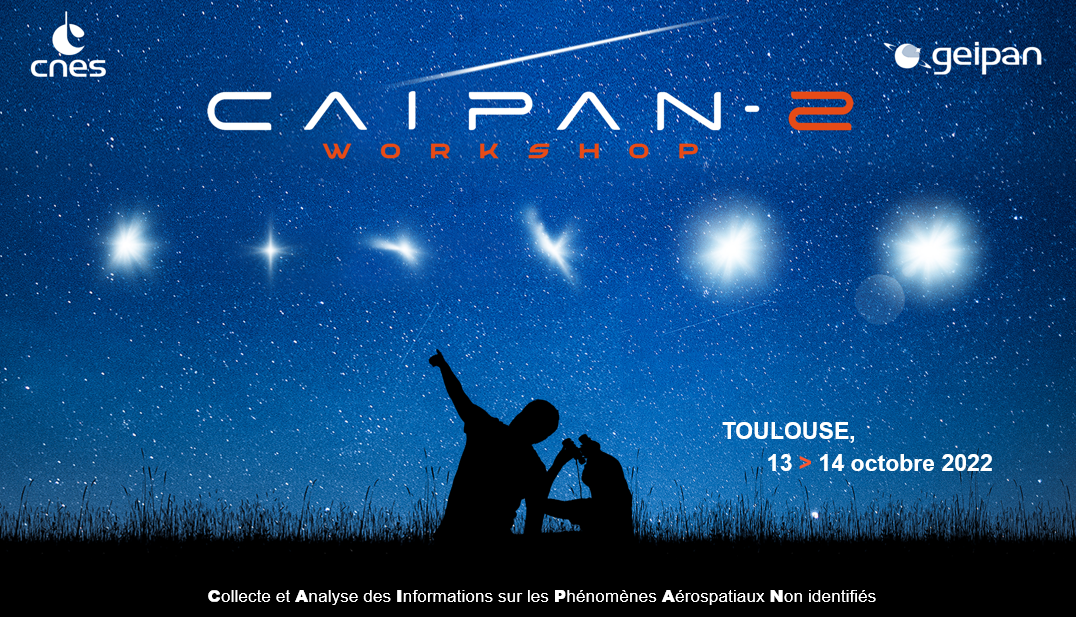On Thursday 13 and Friday 14 October 2022, the Study and Information Group on Unidentified Aerospace Phenomena (GEIPAN), a technical department of CNES, organised the CAIPAN II conference in Toulouse, an international symposium devoted to surveys, knowledge and expertise on unidentified aerospace phenomena.. During these two days, more than 100 participants – scientists, technical experts, investigators and associations linked to the fields of ufology – presented their work. The topics covered are the investigations carried out on observations ofand the means, techniques and knowledge used in the analysis of testimonies.
Participation was international with 13 nationalities and notably the intervention of Daniel A. Evans, Deputy Director of R&D for NASA scientific programs and project manager of the new study group led by NASA on. He presented the US space agency's roadmap for the(UAP). An independent and dedicated team was set up by NASA with the objectives of "analyzing thewith a scientific approach and NASA's use of scientific data and tools to advance knowledge."
On the occasion of these two days of exchanges and meetings of the community dedicated to expertise on, GEIPAN has exposed a very original and little-known phenomenon that addresses several technical disciplines. If this has already been encountered by GEIPAN, it is now explained, clarified and popularized. This type of phenomenon is new to GEIPAN. It illustrates very well the approach of GEIPAN and the diversity and complementarity of disciplines. Astronomers, optical engineers and doctors were notably solicited. Some testimonies of observations in the sky are now explained by the observer himself.
As a reminder, GEIPAN rationally explains strange observations reported by witnesses. Its mission is to collect, analyze, anonymize, archive and publish witness reports of. It is science at the service of society with the particularity of being in direct interface with the general public, of listening to witnesses. For this mission, the CNES relies on both internal and external skills: trained volunteers who investigate, experts from very varied scientific disciplines and institutional partners (National Gendarmerie, Air Force, Civil Aviation, Navy, Météo France, CNRS, etc.).
Informing the witness and the general public is a very important point. It is a work in complete transparency that shows the technical integrity of GEIPAN and allows the scientific community and everyone to analyze and follow up on the observations and analyses. The reports are published on the website, https://www.cnes-geipan.fr .
GEIPAN is supervised by a steering committee chaired by a recognized person from the aerospace world and composed of representatives of the country's civil and military authorities (National Gendarmerie, Civil Aviation, Weather, Air Force, Scientific Research) and the CNES. This committee's mission is to analyze the results of GEIPAN and make recommendations to the CNES on its orientations.
CAIPAN II international conference on unidentified aerospace phenomena organized by GEIPAN in Toulouse.
Thursday 13 and Friday 14 October, the GEIPAN research and information group dedicated to unidentified aerospace phenomena (UAP) at CNES organized the CAIPAN II international conference in Toulouse to review advances in investigations, knowledge and expertise in the field of UAPs. During the two-day event, more than 100 scientists, technical experts, investigators and associations with an interest in UAPs presented their work, covering investigations of UAP sightings and the resources, techniques and know-how employed to analyze witness accounts.
The conference was attended by participants from 13 nations and addressed by Daniel A. Evans, Assistant Deputy Associate Administrator for Research within NASA's Science Mission Directorate, who leads the agency's new study team focused on UAPs. He presented NASA's roadmap for this team, which aims to “examine UAPs from a scientific perspective and focus on identifying available data, how best to collect future data, and how NASA can use that data to move the scientific understanding of UAPs forward”.
Over these two days of discussion among the UAP community, GEIPAN presented a highly original yet relatively unknown phenomenon that cuts across a number of technical disciplines. While GEIPAN has already encountered the phenomenon in the past, it is now explained, detailed and mediated. It is a good illustration of GEIPAN's approach and the diversity and complementarity of disciplines, notably involving astronomers, optical engineers and physicians. Indeed, observers are now capable of explaining certain things they have seen in the skies themselves.
GEIPAN seeks to give a rational explanation for strange phenomena seen by observers. Its mission is to collect, analyze, anonymize, archive and publish insights of UAPs. It is putting science to work for society, working in direct contact with the general public and listening to witness accounts. To this end, CNES is able to call on both its own internal and outside expertise from trained volunteer investigators, experts in a wide range of scientific disciplines and institutional partners (Gendarmerie, French Air Force, civil aviation, French Navy, Météo France national weather service, CNRS national scientific research center, etc.).
Informing witnesses of UAPs and the general public is a very important aspect of what GEIPAN does. Its commitment to transparency and technical integrity give the scientific community and lay public the means to assess and follow up observations and analyses. Reports are published on its website at https://www.cnes-geipan.fr.
GEIPAN is overseen by a steering committee chaired by a person who is a recognized authority from the world of aerospace and made up of representatives from the nation's civil and military authorities (Gendarmerie, civil aviation, national weather service, Air Force, scientific research) and CNES. The committee's mission is to analyze GEIPAN's results and make recommendations to CNES on its future direction.

